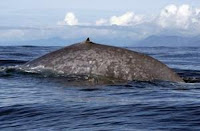
The first known migration of giant blue whales from the coast of
A blue whale spouts off
In all the years that I have been, “messing about in boats,” from the
Researchers from Cascadia Research Collective in Washington, NOAA's Southwest Fisheries Science Center in California, and Canada's Department of Fisheries and Oceans used the blue whale’s distinctive pigmentation patterns of their skin color and the shape of the dorsal fin to positively match individuals seen in the north Pacific with those off of California.
north Pacific with those off of California.
Researchers identified individual blue whales by the shapes of their small dorsal fins. (Photo by John Calambokidis courtesy Cascadia Research Collective)
Reaching lengths of nearly 100 feet, the blue whale is the largest animal on Earth today and the largest known to have ever existed.
They were nearly hunted to extinction throughout the world and are currently listed as endangered under the U.S. Endangered Species Act, the Canadian Species at Risk Act, and on the authoritative IUCN Red List.
During the early 1900s in the North Pacific and along the West Coast as far south as Baja California, blue whales were nearly wiped out during commercial whaling activities. Because they were the largest whales, blue whales were a prime target for whalers.
John Calambokidis of the Cascadia Research Collective, who has a long history of blue whale research, said of this study, "We document 15 blue whale sightings off British Columbia and in the Gulf of Alaska made since 1997, and use identification photographs to show that whales in these areas are currently part of the California feeding population."The scientists are still not certain why blue whales are now beginning to migrate from southern California to the North Pacific Ocean, although changing ocean conditions may have shifted their primary food source of krill further north.
Living between 70 and 80 years, blue whales reproduce every two or three years. There are an estimated 5,000 to 12,000 animals surviving today, with the largest population of approximately 2,000 off the U.S. West Coast.
Click here to view the research paper, "Insights into the population structure of blue whales in the Eastern North Pacific from recent sightings and photographic identification."
On a similar note click here to see one of the first underwater videos of a blue whale calf in the waters off Puerto Rico.





No comments:
Post a Comment